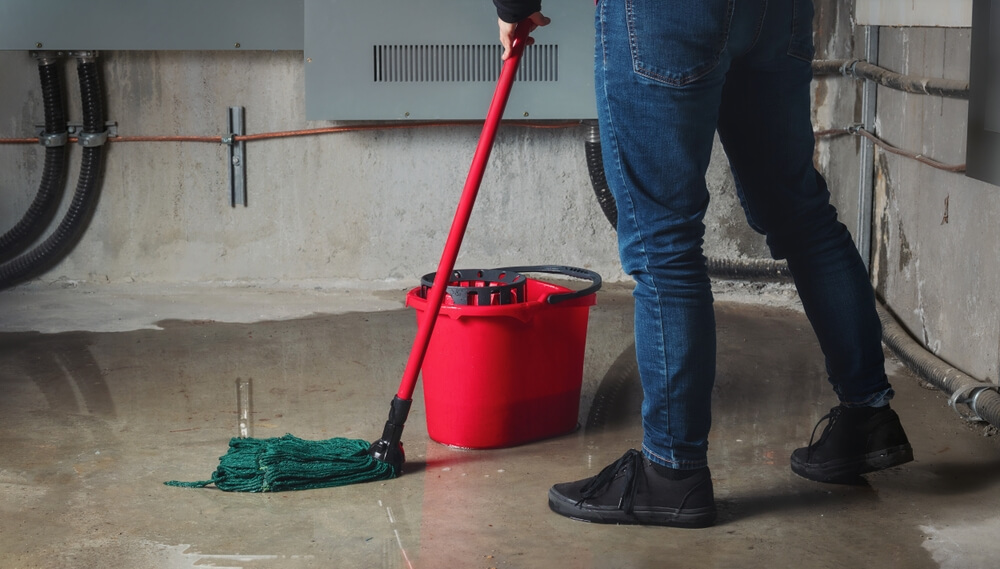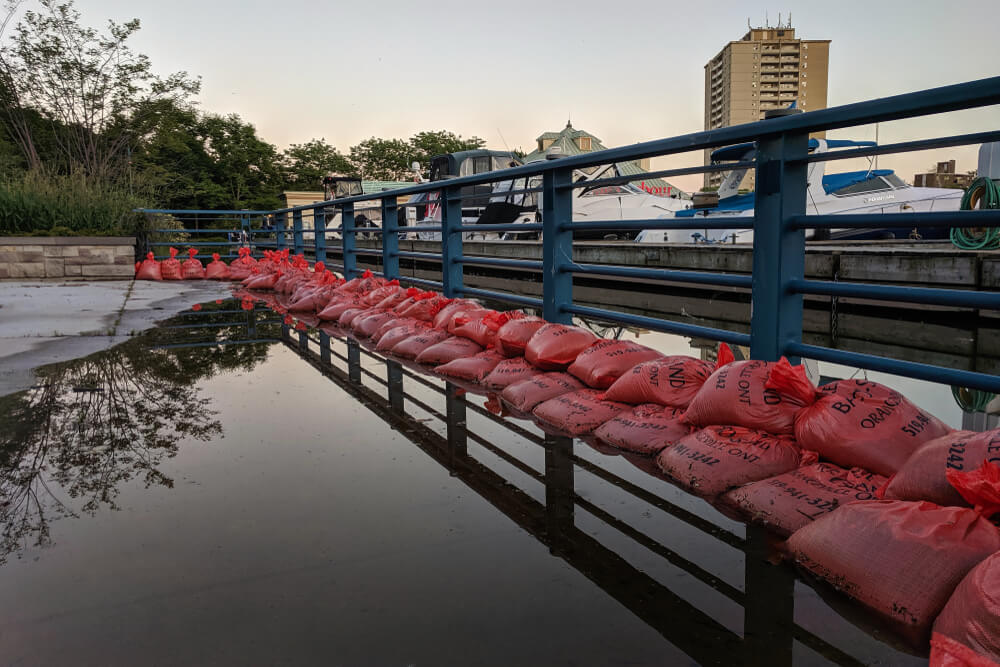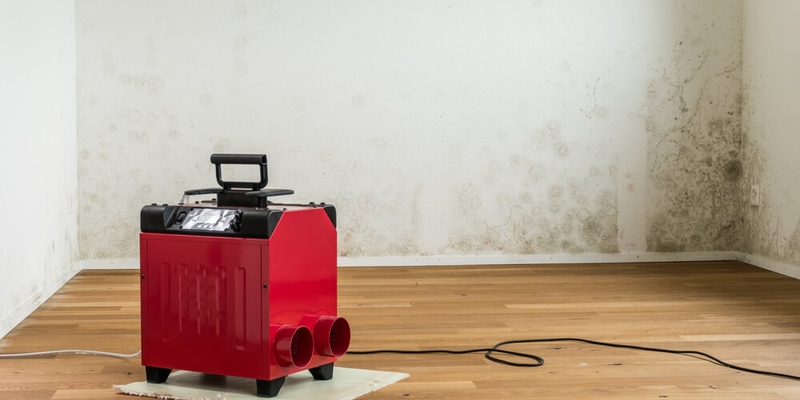
If you are not redirected within 30 seconds, please click here to continue.
Samedi: 10h – 16h HAE

If you are not redirected within 30 seconds, please click here to continue.
If you are not redirected within 30 seconds, please click here to continue.
How to prevent basement from flooding before heavy rain

There’s nothing more nerve-wracking than being in a heavy rainstorm and hoping your basement stays dry.
To prevent your basement from flooding ahead of heavy rain, make sure your downspouts and eavestroughs are clear of debris, that any cracks and leaks around your foundation are sealed, and lastly, invest in some structural improvements for long-lasting support.
Without preventative measures, homeowners in cities across Ontario may open themselves up to the possibility of sopping wet floors and ruined keepsakes several times a year.
The reason for these more frequent destructive storms? Dr. Blair Feltmate, head of the Intact Centre on Climate Adaptation at the University of Waterloo says that that Southern Ontario municipalities have drastically reduced the natural infrastructure such as forests, fields and wetlands. That means the water has nowhere to go.
“When water hits pavement, it runs off instantly and goes to the lowest location around which very often could be people's basements,” he says.
What does a flood-prone home look like?
Your home has a higher chance of flooding if:
- There are any leaks or cracks in the foundation
- The seals around the basement windows are damaged
- The land around your home is graded to slant towards your foundation instead of away. This includes the driveways that are slanted towards the house
- Leaves and other debris are clogging the eavestrough, downspouts and the drains
- Your sump pump hasn’t been properly maintained and is clogged with sludge, dirt, and debris.
If you live in the Greater Toronto Area and want to know if your neighbourhood floods, the Toronto and Region Conservation Authority has maps where you can type in your postal code and see if you live in a flood-prone area.
Fortunately, there are easy and affordable ways to prevent flooding in your home. To put it in perspective, the average cost to repair a basement after flooding is $40,000 – but prevention can cost as little as $250.
Seek proactive protection for water
Did you know that water insurance is not included in the standard home insurance policy? And that up to 10% of homes in the country are not even eligible for coverage due to being at too high of a risk?
In a recent report, RATESDOTCA found that nearly half of new home insurance customers added some type of water endorsement — including overland water and sewer back-up — to their home insurance queries – an increase of 68% from the previous year.
Clean up, check and repair
One of the easiest things to do to keep water from getting into your home is to regularly clear your eavestroughs, downspouts and drains of dirt, leaves and other debris. Once that’s done, survey the rest of your home, including the roof, for any leaks and cracks and repair them. Water takes the path of least resistance and is naturally drawn to cracks and leaks.
After that, check your sump pump and backwater valves to see if they’re working. If your sump pump has a battery backup, make sure you have fresh batteries. Feltmate says a storm can cause electricity to shut off, or providers might turn off power; they're scared of people walking into a basement full of water and getting electrocuted.
“So, by the time you need the sump pump to actually do something is when it may not be available in the event of an outage,” he says. “You want to make sure you have a battery backup or an external generator to run the sump pump for 42 to 72 hours.”
Related: How to lower home insurance rates by keeping your home in good shape
Inexpensive fixes
Water loves an easy path and uncovered basement windows are an invitation. Block water by installing window coverings – you can buy them from any home store starting from $35. Feltmate also recommends redirecting your downspouts at least two metres away from your foundation. He also suggests storing any valuables in waterproof containers and keeping them off the floor and installing a flood alarm.
Another thing people can do is to keep the flood drain in their homes unobstructed.
“One of the things that I was shocked by is that 35% of the homes we went into [for a study], have the floor drain blocked, either tiled over or otherwise,” he says.
Structural solutions
If your situation requires more dramatic solutions for future prevention, you can invest in landscaping like a rain garden to gather stormwater. The recommendation is to have your landscaping five metres away from the foundation. That way the water can run off into the ground.
If you find that after heavy rain, water ends up pooling around the foundation of your home, it may be worth looking into regrading the land around your house. This can be done either through adding (or removing) soil to create a slope away from your home, or with the help of a concrete specialist.
Finally, if you haven’t already, install a sump pump and a backwater valve. The valve prevents sewage from flowing back through your pipe and ending up in your basement.
Most municipalities offer some kind of rebate program to ease the financial burden of flood-proofing your home. For example, Toronto homeowners can apply for a subsidy up to $3,400 per property providing it’s a single-family, duplex, triplex or fourplex house.
You can use the subsidy to install a sump pump, a backwater valve and cap your storm sewer. Mississauga has a rebate program of up to $7,500 which helps with sump pumps and backwater valves.
Without prevention, flooded basements are here to stay
Heavy rain isn’t going away – in fact, it’ll probably get even worse over time.
“Climate change is irreversible, period,” he says. “We should work to mitigate the discharge of greenhouse gasses into the atmosphere to slow down the rate of change, but the most we could do is slow it down. As a result of that, precipitation events are going to get increasingly challenging going forward, because warmer air holds more moisture.”
He says that when areas get major precipitation events, they have more water coming down over shorter periods of time, contributing to flood risk.
Doing a little – or a lot of – prep work will reduce the risk of basement flooding and save you thousands of dollars’ worth of repairs.
Lastly, it’s become more imperative than ever to make sure you’re insured for water insurance. Compare rates for the best options available for you.
Don't waste time calling around for home insurance
Use RATESDOTCA to shop around and compare multiple quotes at the same time.
Finding the best home insurance coverage has never been so easy!
Get money-saving tips in your inbox.
Stay on top of personal finance tips from our money experts!










